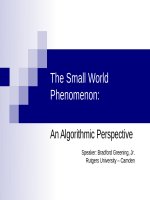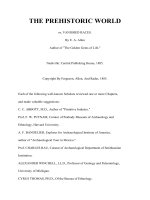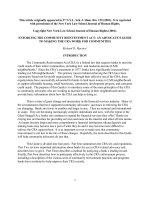The Small World Phenomenon: An Algorithmic Perspective
Bạn đang xem bản rút gọn của tài liệu. Xem và tải ngay bản đầy đủ của tài liệu tại đây (1.22 MB, 34 trang )
The Small World
Phenomenon:
An Algorithmic Perspective
Speaker: Bradford Greening, Jr.
Rutgers University – Camden
2
An Experiment by Milgram (1967)
Chose a target person
Asked randomly chosen “starters” to forward a
letter to the target
Name, address, and some personal information were
provided for the target person
The participants could only forward a letter to a single
person that he/she knew on a first name basis
Goal: To advance the letter to the target as quickly as
possible
3
An Experiment by Milgram (1967)
Outcome revealed two fundamental components
of a social network:
Very short paths between arbitrary pairs of nodes
Individuals operating with purely local information are
very adept at finding these paths
4
What is the “small world” phenomenon?
Principle that most people in a society are linked by short
chains of acquaintances
Sometimes referred to as the “six degrees of separation”
theory
5
Create a graph:
node for every person in the world
an edge between two people (nodes) if they know
each other on a first name basis
If almost every pair of nodes have “short” paths between
them, we say this is a small world
Modeling a social network
6
Modeling a social network
Watts – Strogatz (1998)
Created a model for small-world networks
Local contacts
Long-range contacts
Effectively incorporated closed triads and short
paths into the same model
7
Modeling a social network
Imagine everyone
lives on an n x n grid
“lattice distance” –
number of lattice steps
between two points
Constants p,q
8
Modeling a social network
p: range of local contacts
Nodes are connected to all
other nodes within distance
p.
9
Modeling a social network
q: number of long-range
contacts
add directed edges from
node u to q other nodes
using independent random
trials
10
Modeling a social network
Watts – Strogatz (1998)
Found that injecting a small amount of randomness
(i.e. even q = 1) into the world is enough to make it a
small world.
11
Modeling a social network
Kleinberg (2000)
Why should arbitrary pairs of strangers, using only
locally available information, be able to find short
chains of acquaintances that link them together?
Does this occur in all small-world networks, or are
there properties that must exist for this to happen?
12
Modeling a social network
Pr [u has v as its long range contact] :
Infinite family of networks:
r = 0: each node’s long-range contacts are chosen
independently of its position on the grid
As r increases, the long range contacts of a node become
clustered in its vicinity on the grid.
:
[ ( , )]
[ ( , )]
r
r
v v u
d u v
d u v
−
−
≠
∑
13
The Algorithmic Side
Input:
Grid G = (V,E)
arbitrary nodes s, t
Goal: Transmit a message from s to t in as
few steps as possible using only locally
available information









